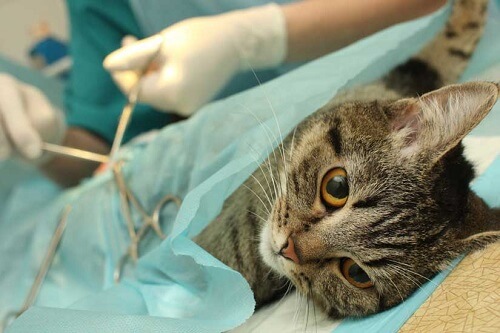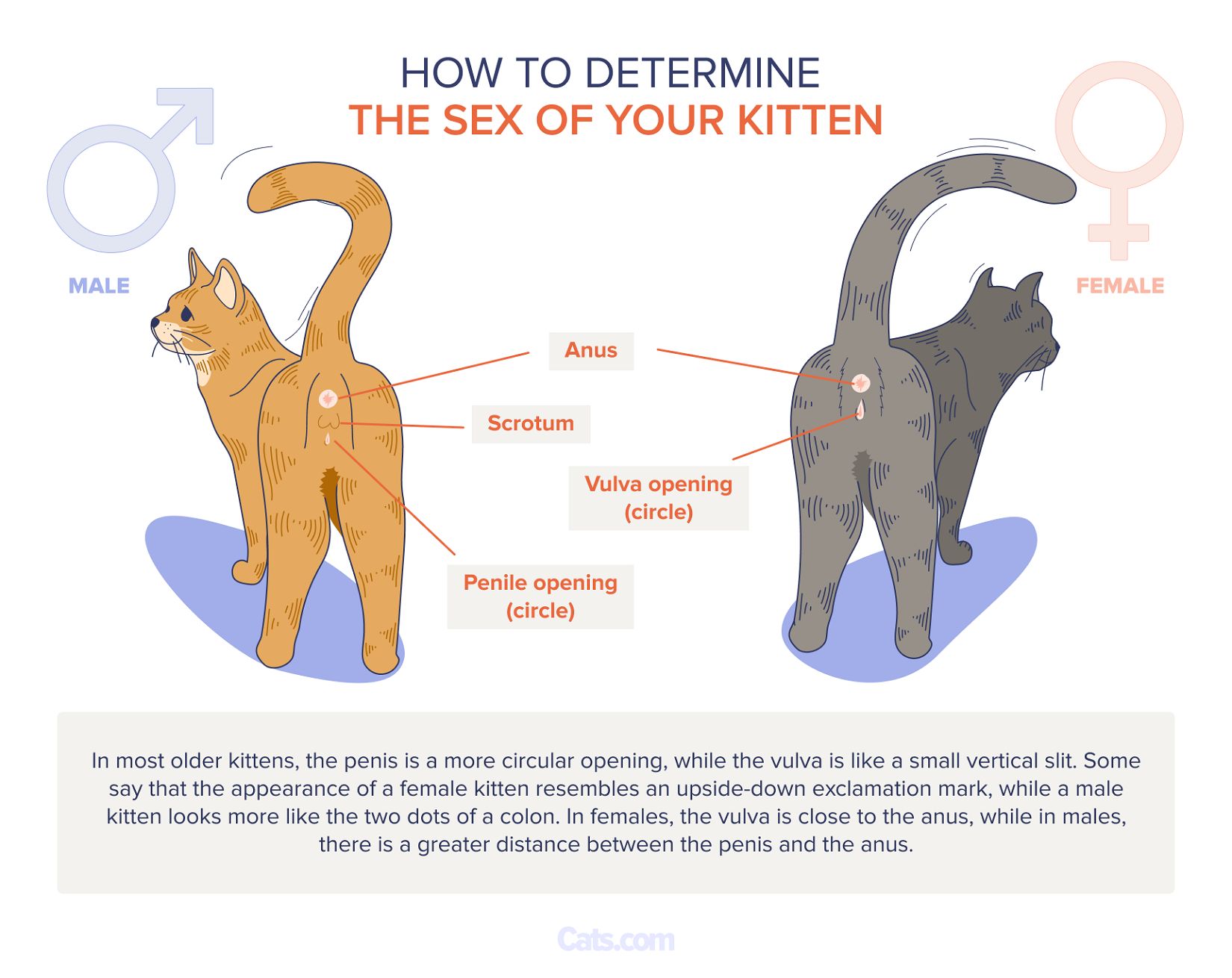
Determining whether a cat is male or female can present a challenge. While determining the sex of an adult cat can be tricky, it can sometimes seem nearly impossible in kittens!
Understanding the differences between male and female anatomy can help make this process easier. Read on for details on the feline reproductive system, and scroll down to the bottom of this article for a feline genitalia guide that will help you to identify the differences between male and female cats.
The Female Reproductive System

First, let’s talk about the female reproductive system in cats.
The primary sex organ in female cats is the ovary. Female cats are typically born with two ovaries, which begin to produce eggs and sex hormones once a kitten reaches approximately six months of age.
The female sex hormones play an important role in the sexual development and pregnancy of intact female cats. Estrogen is required for the development and maturation of eggs, while progesterone acts primarily to prepare the body and uterus for pregnancy.
The ovaries are located on either side of the body, near the kidneys. They are connected to the uterus by oviducts, also known as Fallopian tubes. There are two oviducts, one for each ovary.
When an egg is released from the ovary, it travels down the oviduct towards the uterus. The oviduct is where fertilization with sperm occurs; the fertilized egg then enters the uterus to implant in the uterine wall.
The uterus of a cat, like the human uterus, is where pregnancy develops. However, the uterus of a cat has a very different shape than a human uterus. While a human uterus looks like an upside-down pear, the feline uterus consists of two long uterine horns, connected in a “V” shape.
The feline uterus is described as bicornuate, meaning “two horns.” These long uterine horns allow for multiple kittens to simultaneously develop within the uterus.
The uterus is sealed off from the outside world by the cervix. The cervix remains tightly closed much of the time, especially during pregnancy. This helps keep bacteria from entering the uterus and causing infection.
The cervix separates the uterus from the vagina, which is a muscular tube that connects the uterus to the external vulva.
The Estrous Cycle

Cats go into estrus, or heat, seasonally. Their estrous cycle, or heat cycle, is controlled by day length. Outdoor cats have more frequent estrous cycles in the spring and summer, when the days are longer. Thanks to artificial lighting, however, indoor cats may cycle year-round.
When the brain senses adequate daylight, it releases a hormone called follicle-stimulating hormone (FSH). Follicle-stimulating hormone stimulates egg follicles within the ovary to develop and mature, while also stimulating the ovary to produce estrogen. This hormone cascade triggers the beginning of the estrous cycle.
There are a number of behaviors that may indicate that your cat is in heat. Unlike dogs, cats do not typically have visible bleeding while in heat. Instead, your cat may become extremely affectionate, often rubbing against their owners or rolling on the floor to solicit affection. She may urinate more often than usual or mark vertical surfaces outside her litterbox.
Finally, you may notice an increase in the number of intact male cats (tomcats) that are hanging around your house, because they are attracted by the smell of a female in heat.
Unlike many other mammals, cats do not automatically ovulate (release eggs) once they are in heat. Instead, cats are induced ovulators. They do not ovulate until they mate with a male. Mechanical stimulation of the vagina and cervix leads to the release of luteinizing hormone (LH), a hormone that triggers ovulation. If a female is not bred while she is in heat, no eggs will be released.
The Effects of Spaying a Female Cat

You may choose to have your cat spayed in order to prevent pregnancy and lower the risk of health issues related to the female reproductive tract.
When a female cat is spayed, her entire reproductive tract is removed, from the ovaries to the cervix. (Less commonly, veterinarians may perform a surgery called an ovariectomy, in which the ovaries are removed but the oviducts, uterus, and cervix are left behind.)
There are two primary effects of this surgery. First, the ovaries are no longer producing eggs; therefore, the female can no longer become pregnant. Additionally, the ovaries are no longer producing sex hormones.
Therefore, the spayed female cat does not experience the same hormonal fluctuations that an intact female cat does. Spayed female cats will no longer go into heat or attract males.
The long-term benefits of spaying your cat are numerous. Spaying a cat early in life significantly reduces the risk of developing mammary (breast) cancer, which is often malignant in cats and potentially fatal.
Additionally, spaying your cat also eliminates the risk of ovarian, uterine, and cervical cancer. Spayed female cats are also less likely to roam, less likely to mark indoors, and tend to have a longer lifespan than intact female cats.
The Male Reproductive System

The male reproductive system has unique features that affect multiple aspects of the cat’s physiology, behavior, and more.
The primary sex organ in male cats is the testis or testicle. The testes produce sperm and the male sex hormone, testosterone. Testosterone is required for maturation of the male reproductive organs (such as the prostate) and for sexual behavior.
The testes are housed within the scrotum. The internal body temperature is too high to allow for sperm to mature; the scrotum allows the testes to remain outside the body, at a cooler temperature that is conducive to sperm production.
Sperm travels from the testicle to the epididymis. Sperm mature in the epididymis and are stored there until ejaculation. They sperm are then combined with the fluid portion of semen, which is created by the prostate gland, and travel through the ductus deferens to the urethra for ejaculation.
The Effects of Neutering a Male Cat

Neutering a male cat helps to reduce the risk of health issues and behavioral problems related to the reproductive system.
Neutering a male cat not only stops the production of sperm, it also stops the production of testosterone. This means that your neutered male cat is less likely to roam, less likely to urine-mark, and less likely to show aggression towards house-mates. Additionally, neutering your cat eliminates the risk of testicular cancer and reduces the likelihood of prostate problems.
Determining the Sex of Kittens

Unlike dogs, which have an obvious penis that is visible from an early age, the differences between male and female cats are relatively subtle. Male kittens often do not have visible testicles until they are two to three months old, which can make determining their sex before this time more challenging than it is in adult cats.
When determining the sex of a kitten, the first step is to lift the kitten’s tail. When you do so, you will see the anus located immediately below the tail. Below the anus is the genital opening.
This opening is round in males, while it appears as a vertical slit in females. Additionally, the genital opening in a female kitten will appear to be closer to the anus than the genital opening of a male kitten. If testes are beginning to descend into the scrotum, you may notice a small swelling between the anus and the genital opening of a male kitten.
You can also use punctuation marks as an analogy for feline genitalia. A male kitten’s genital area will look like a colon ( : ) with the anus on top and a round genital opening below. A female kitten’s genital area will look more like a semicolon ( ; ) with the anus on top and a vertical slit of a genital opening below.
In addition to the genital openings, color can be helpful in determining sex. The overwhelming majority of calico and tortoiseshell cats (black, white, and orange in combination) are females; it is rare to see a calico or tortoiseshell male.
Orange cats are usually males, although the link between orange color and male sex is much weaker than the link between calico/tortoiseshell color and female sex.
Consult Your Veterinarian
If you have any questions about your cat’s reproductive health or about how to sex a kitten, consult your veterinarian. They can perform a thorough physical exam and answer any questions that you may have about your cat’s genitals or reproductive health.
Frequently Asked Questions
What does a male cat’s privates look like?
If you lift a male cat’s tail, you will see two round openings. The larger opening (closer to the tail) is the anus, while the smaller opening is the genital opening. This in in contrast to females, whose genital opening looks more like a slit than a round opening.
At what age can you tell the gender of a kitten?
Even veterinarians may struggle to determine the age of a newborn kitten. In most cases, the age of a kitten becomes easier to determine at approximately 4-6 weeks old.
Are male cats better than female?
Every cat owner has their own distinct preference. Males have a reputation for being more friendly than females, which is appealing to many people, but they also may be more likely to urine mark within the home. Like humans, though, cats are individuals. While people may attempt to generalize about the differences between them, there are always exceptions to those stereotypes.








The vet that altered my kitten at six weeks said it is a male. The vet that gave it’s vaccines says it’s female. Who should I believe. It’s momma was a short haired orange tabby. The kitten has longer fur but is more tan in color tabby. I was told it was rare to have a female.
I would hope that the vet who altered your cat knows their sex. If they were mistaken about that, I really wouldn’t want them doing a spay/neuter operation. 🙂 I’d go with their opinion, but you don’t have to take their word for it. As you can see in this article, male and female genitalia look different in cats, including ones who’ve been neutered, so you should be able to do a little lift of the tail and figure it out for yourself.